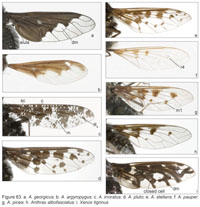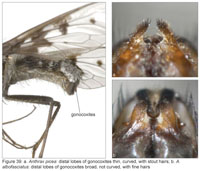
| Introduction | Checklist | Key to genera | Species keys | Gallery | References | PDF 41.7 MB | Cite this Article | Updates |
The Bee Flies (Diptera: Bombyliidae) of Ontario, with a Key to the Species of Eastern Canada
CJAI 06 March 06, 2008
doi: 10.3752/cjai.2008.06
Joel H. Kits* , Stephen A. Marshall* , and Neal L. Evenhuis**
* Department of Environmental Biology, University of Guelph, 50 Stone
Rd. E., Guelph, Ontario N1G 2W1, Canada jkits@uoguelph.ca, samarsha@uoguelph.ca
** Department of Natural Sciences, Bishop Museum, 1525 Bernice Street,
Honolulu, Hawaii 96817, USA neale@bishopmuseum.org
6. Key to the Anthrax species of Ontario and eastern Canada
Larvae of all Ontario species except A. georgicus are probably parasitoids of solitary wasps and bees. Key based on Marston (1963, 1970)
| 1. | Wing solid black at the base, not broken into spots (Figure 63a,b) | 2 |
| - | Wings spotted (Figure 63c-h) | 3 |
| 2. | Posterior margin of alula convex; wing broad (Figure 63a) | georgicus |
| Formerly known as A. analis. 7-10 mm. Larvae are parasitoids of Cicindellidae (tiger beetles). Widespread in Ontario north to Algonquin Provincial Park (widespread, Canada south to Nicaragua; also Cuba). Adults fly July – Sept. | ||
| - | Posterior margin of alula straight; wing elongate and narrow (Figure 63b) | argyropygus |
| 7-8 mm. One Ontario record, from Jordan (Sept.) (widespread from U.S. into central Mexico; also Cuba). |
| 3. | Wing with numerous spots beyond the bases of cells (Figure 63c-e). Medial angle of crossvein m usually with a short spur and a distinct spot; vein R4 with a short spur (Figure 63c-e) | 4 |
| - | Spots on wings restricted to bases of cells (Figure 63f-h). Medial angle of crossvein m without a spur or spot; medial angle of R4 without a spur (Figure 63f-h) | 6 |
| 4. | Cells c and sc with alternating dark and clear spots; many large and small spots, not all connected to veins (Figure 63c) | irroratus |
| 5-10 mm. Widespread in Ontario north to north shore of Lake Superior (widespread from Canada south to Honduras; also Puerto Rico). Adults fly late May to Sept. | ||
| - | Cells c and sc entirely brown; spots large and connected to veins (Figure 63d,e) | 5 |
| 5. | Femora brown, hind femur with brown scales, abdominal sternites with brown and white tomentum (Figure 38a) | stellans |
| 12 mm. Widespread but rarely collected in Ontario (western and eastern Canada, south into New Hampshire, and western cordillera to Mexico). Adults fly June – July. | ||
| - | Femora black, hind femur with black scales, abdominal sternites with black and white tomentum (Figure 38b*) *updated 26/03/2008 | pluto |
| 11-12 mm. Confirmed records from Windsor and Guelph, unconfirmed literature record from Algoma District (Williamson 1907) (also fairly widespread in central U.S.). Adults recorded in July and August. |
| 6. | Cell r4 with a spot at base (Figure 64g,h) | 7 |
| - | Cell r4 clear at base (Figure 64f) | pauper |
| 7 mm. One Ontario record, from Jordan (July) (Rockies east to Great Lakes area and New York and Maryland). |
| 7. | Cell m1 with a large spot at base (Figure 64g). Distal lobes of male gonocoxites more than twice as long as the width of one lobe at the base and curved inwards, with stout hairs at tip (Figure 39b) | picea |
| 8-10 mm. Found in boreal areas in Ontario (widespread in Canada, south to northern U.S.). Adults fly in July. | ||
| - | Cell m1 with spot at base often faint or absent (Figure 64h). Distal lobes of male gonocoxites less than twice as long as the width of one lobe, not incurved, with fine hairs at the tip (Figure 39c) | albofasciatus |
| 4-11 mm. Widespread in Ontario north to Sudbury (widespread from Canada south to Honduras; also Brazil). Adults fly June – early Sept. | ||
| These species are closely related and are best separated by geography and male genitalia; females from central Ontario may not be identifiable. |
| Introduction | Checklist | Key to genera | Species keys | Gallery | References | PDF 41.7 MB | Cite this Article | Updates |



